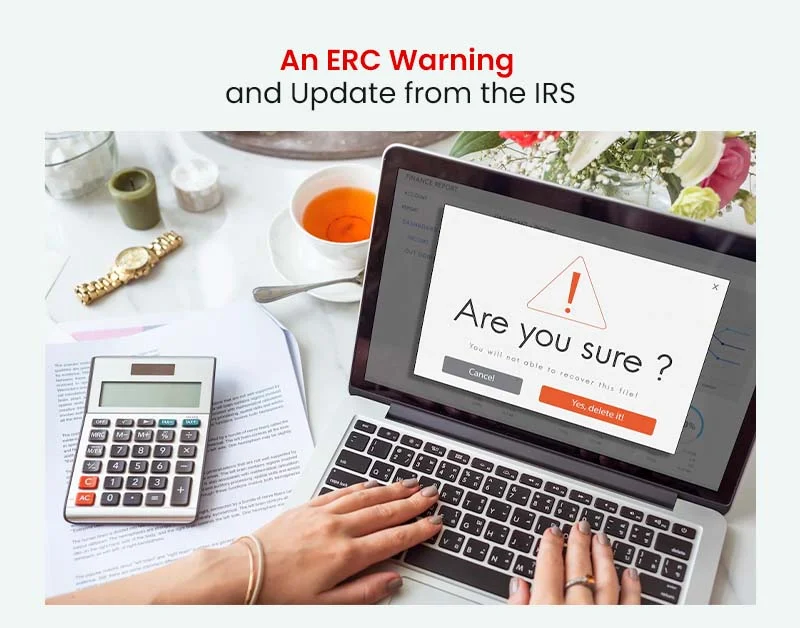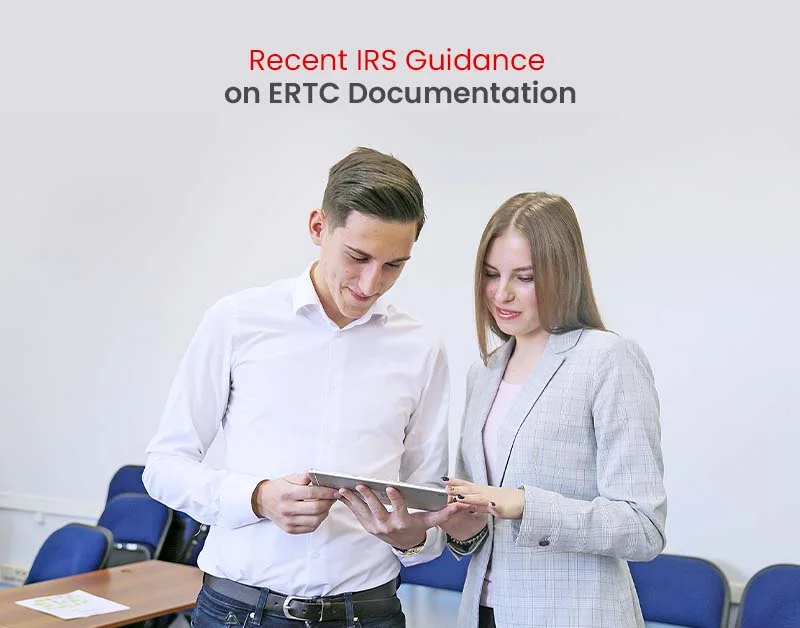During the difficult times created by the COVID-19 pandemic, the Employee Retention Tax Credit (ERTC) has been a lifeline for businesses and employees. As companies navigate an ever-changing economic situation, the IRS has released regular ERC tax credit updates and guidance on this critical tax benefit.
These improvements are intended to give employers clarity and support, allowing them to make educated decisions about retaining their workers while taking advantage of available tax breaks.
This blog discusses the IRS’s employee retention tax credit updates and how it affects businesses and employees.
Key Takeaway:
- Employee Retention Credit 2023 assists both businesses and employees during difficult times.
- It promotes employment retention by providing tax breaks to eligible firms.
- Eligibility criteria vary depending on things such as business size and income.
- To react to changing conditions, the IRS frequently modifies ERTC standards.
- Avoid double-dipping by claiming both ERTC and PPP.
- Documentation is required to support ERTC claims and compliance.
- To avoid fraud in ERTC assistance, verify adviser credentials and obtain referrals.
Introduction to Employee Retention Tax Credit (ERTC)

The Employee Retention Tax Credit (ERTC) is a significant financial recovery program implemented by the United States government to assist businesses through difficult economic times, particularly in response to the COVID-19 pandemic.
The purpose is to provide refundable tax relief to eligible companies to assist them in maintaining a healthy workforce.
Understanding the ERTC’s purpose and significance is critical for businesses and employees since it contributes to company sustainability and preserves jobs and financial security during economic chaos.
Gaining Insight into the Significance and Purpose of ERTC
The primary goal of the employee retention tax credit (ERC) is to encourage businesses, particularly those affected by the pandemic, to retain their employees rather than lay them off.
The employee credit aims to stabilize the labor market, reduce unemployment, and promote economic recovery efforts by giving a cash incentive to qualifying firms.
Notably, the ERTC has a wide range for workers and their communities in addition to companies. It assists workers in retaining job security, obtaining a consistent income, and maintaining critical benefits.
They are such as health insurance, contributing to the financial stability of countless homes nationwide. Furthermore, the ERTC indirectly benefits the local economy by guaranteeing that consumers have the spending power to stimulate economic activity.
ERC Tax Credit Eligibility Overview
Employers must meet specific eligibility conditions imposed by the IRS to enjoy the employee retention tax credit advantages. Even though the rules and regulations can be complicated, here is a quick rundown of the essential eligibility requirements and ERC credit update:
Employer Type
Businesses of all sizes, tax-exempt organizations, and government agencies are all eligible employers. On the other hand, state employers and entities that receive subsidies for operators of closed sites are typically excluded.
Impact Criteria
Employers must meet the eligibility criteria. Due to the pandemic, they must show a considerable drop in gross receipts. Initially, a 50% decrease in gross receipts in a calendar quarter compared to the previous year’s quarter was required.
This criterion, however, evolved as the pandemic progressed, with revisions made by the IRS to account for shifting economic situations.
Partial Suspension
Employers may also be eligible if they face a partial or total suspension of activities due to government orders restricting commerce, travel, or group gatherings.
Qualified Wages
The credit is calculated based on qualifying salaries paid to qualified employees. Qualifying wages are often salaries provided to workers who did not perform during bad economic times for companies with more than 100 full-time employees.
All employees’ pay may be eligible for organizations with 100 or fewer full-time employees.
Maximum Credit.
In 2020, the ERTC can be up to $5,000 per qualified employee; in 2021 and 2022, it can be up to $7,000 per eligible employee per quarter.
An ERC Warning and Update from the IRS

During the challenging economic circumstances caused by the COVID-19 pandemic, the Employee Retention Tax Credit (ERTC) has been a vital lifeline for businesses. However, as the IRS continues to modify its principles, companies must be watchful and updated on the newest developments and ERTC requirements.
This section will cover the most recent ERTC rules modifications and go into fundamental changes and expansions that can substantially impact enterprises.
Most Recent Updates in ERTC Guidelines
Quarterly Changes
The IRS update portal has periodically updated ERTC rules to reflect the growing pandemic. Employers should check for IRS updates today to ensure compliance with the most recent new employee retention credit regulations.
Maximum Credit
The maximum ERTC per eligible employee per quarter has been increased to $7,000 for 2021 and 2022, providing an even greater incentive for firms to retain employees.
Full Vaccination
Employers must now consider an employee completely immunized if they have received the recommended doses of a COVID-19 vaccination. This impacts eligibility, particularly for firms that use employee vaccination status as an ERTC factor.
Third-Party Payers
The IRS clarified that eligible employers using third-party payers to report their federal employment taxes can still claim the ERTC. This update ensures businesses can leverage the credit while outsourcing their payroll functions.
Notable Changes and Extensions Affecting Businesses
Extension through 2022
The ERTC, which was supposed to terminate in 2021, has been extended until 2022. This extension allows businesses more time to use the loan, allowing them to continue their efforts to retain personnel and maintain financial stability.
Double-Dipping Prohibition
The IRS has strictly barred businesses from claiming the ERTC and other pandemic-related relief programs, such as the Paycheck Protection Program (PPP). Companies must understand these initiatives’ laws to avoid penalties and potential audits.
Startup Businesses
Startups operating on February 15, 2020, are now eligible for the ERTC. Initially, these businesses needed to be qualified, but this modification broadens the range of the companies that can apply for loans.
Change in Revenue Threshold
Businesses with a 20% or more significant decrease in gross receipts in a quarter compared to the same quarter in 2019 can qualify for the ERTC in 2021. This lower level allows more enterprises to benefit from the credit.
Modified Gross Receipts Test
Employers can now determine their eligibility using a modified gross earnings test. This test allows you to compare the gross earnings of your current quarter to those of the same quarter in 2019. If the drop is significant, they can stay updated with the ERC news and apply for the ERTC.
Recent IRS Guidance on ERTC Documentation

The Employee Retention Tax Credit (ERTC) has been a critical lifeline for businesses in the face of the COVID-19 pandemic’s economic hardships. The Internal Revenue Service (IRS) has released thorough instructions on the documentation requirements linked with the ERTC application to guarantee appropriate administration and compliance.
Here, we take a closer look at the IRS’s specific paperwork requirements and offer advice on how businesses can ensure compliance with these standards.
IRS Documentation Criteria
Quarterly Wage and Tax Statements
Employers must keep accurate quarterly payroll and tax returns (Form 941) to demonstrate ERTC eligibility. These papers to file taxes should clearly show the wages paid to employees each quarter and any pertinent payroll tax information.
Gross Receipts Records
Businesses must track their gross income for each calendar quarter to establish the needed fall in gross sales to qualify for the ERTC. This comprises sales, services, interest, dividends, and other kinds of revenue.
Documentation of Partial or Full Suspension
Suppose a company obtains ERTC because of a partial or total suspension of activities due to government directives. In that case, it should keep copies of those orders and any documents indicating the impact on its business operations.
Employee Records
Businesses must track the number of employees, wages paid, and hours worked for eligible and non-eligible workers. This information is required to calculate the credit correctly.
Health Plan Expenses
Documentation of qualified health plan expenses that can be used to calculate the ERTC is required. This provides information about employer-sponsored health insurance premiums.
Vendor Invoices and Contracts
To substantiate their claims, eligible employers with lower gross sales may be needed to document supplier invoices and contracts. This data can help determine the scope of the business impact.
Employee Certification
In some situations, employers may demand employee certification to ensure eligibility for the ERTC, such as when evaluating the employee’s status as “severely financially distressed.” Employers must keep these certifications current.
Guaranteeing Conformity to Documentation Standards

Maintain Organized Records
Businesses must build a regular and organized record-keeping strategy. This involves document scanning, backup creation, and ensuring that all relevant data is conveniently available when needed.
Stay Informed
Businesses should stay current on the latest IRS developments because IRS requirements can change over time. Check the IRS website frequently and subscribe to relevant notifications or newsletters to verify your compliance with current regulations.
Seek Professional Guidance
Because of the complexities of tax legislation, ERTC paperwork might be challenging. Using the services of a tax professional or accountant who specializes in this area can be highly beneficial. They can assist in ensuring accuracy and compliance with IRS regulations.
Document Continuously
Create a consistent documentation practice. Waiting until the ERTC is due may result in missing or partial data. Maintain your information, especially during times of economic chaos.
Retain Records for the Statute of Limitations Period
The IRS recommends retaining any records relating to the ERTC for at least four years, beginning with the date the tax return claiming the credit is submitted or the day the tax is paid, whichever comes first.
FAQs About Employee Retention Tax Credit
While the employee retention tax credits were initially scheduled to conclude on October 1, 2021, they remain accessible for use in 2022 and 2023 if your company meets the eligibility criteria. If you didn’t apply for the credit before, you now have the option to seek a retroactive ERTC refund.
If you have a Paycheck Protection Program (PPP) loan, you cannot claim the Employee Retention Credit (ERC) for the same pay. The IRS forbids “double-dipping” using both programs for the same expense.
However, if you did not utilize PPP money to pay that wage, you may be entitled to ERC on payments not covered by the PPP loan or over a separate period. You must understand the precise laws and seek specialized counsel from a tax specialist based on your situation.
After 2023, businesses can no longer claim the ERC on existing salary expenditures. However, the opportunity to save money with this credit is still open. Companies can still file revised reports for eligible wages earned in 2020 and 2021 until 2025.
Employee Retention Credit (ERC) information is often recorded on an employer’s federal income tax return, such as Form 941 for quarterly filers or Form 944 for annual filers. Employers must disclose the total ERC claimed for the corresponding quarter or calendar year and other payroll tax data.
ERC reporting standards and instructions can be obtained on the IRS website or in IRS publications about employment tax filings. In the event of an IRS audit or investigation, employers must retain accurate records of their calculations and ERC evidence.
You must conduct due diligence to protect yourself from shady Employee Retention Credit (ERC) advisers. Examine their credentials, contact references, and look into their web reputation.
Be aware of experts who demand upfront payments or make false promises. Interview potential advisors to assess their compliance experience and approach. Above all, trust your instincts; if something goes wrong, find an advisor whose services inspire confidence.
Contact the Trusted Team at R&R Agency
Contact the trusted team at R&R Agency today to easily navigate the complex ERC application. Our seasoned experts are here to make the process stress-free for your business.
Take advantage of potential ERC credits; speak to our specialists to determine if you qualify. Contact us, and let’s get started today!
Conclusion
In conclusion, remaining current on IRS ERC updates 2023 is critical for firms seeking financial assistance, especially during difficult economic times. Due to the ever-changing norms, qualifying criteria, and paperwork requirements, continuous monitoring and compliance are required.
As the IRS program continues to modify ERTC laws in response to changing economic situations, businesses should keep informed, contact tax specialists as needed, and take advantage of this excellent incentive to assist their staff and maintain long-term financial stability.
Staying educated allows firms to maximize the potential benefits of the ERTC while conforming to laws and regulations.


